Optimal Scheduling of Campus Microgrid Considering the Electric Vehicle Integration in Smart Grid
Abstract
:1. Introduction
- An EMS is proposed for optimal scheduling of available energy resources and grid power using robust Linear Programming based on time of use (ToU) pricing scheme to ensure power supply continuity and reduction in energy consumption cost.
- Power outage and power interruption modes are considered for estimating the effect on cost for continuous power supply.
- Effect of integrating EV as a storage device in the proposed microgrid structure is also considered.
2. Literature Review
3. System Architecture/Description
3.1. Photovoltaic System
3.2. Energy Storage System (ESS)
3.3. Electric Vehicle (EV)
4. Mathematical Modelling
4.1. PV System Modelling
4.2. Energy Storage System Constraints
4.3. Electric Vehicle Constraints
4.4. Grid Connection
5. Objective Function
Solution Methodology
6. Results and Discussion
6.1. Case 1, Grid Only
6.2. Case 2, Grid with PV and ESS
6.3. Case 3, Grid with PV and ESS Considering Power Interruptions
6.4. Case 4, Grid with PV, ESS, and EV
6.4.1. EV as a Load
6.4.2. EV as a Source
7. Conclusions
Author Contributions
Funding
Institutional Review Board Statement
Informed Consent Statement
Data Availability Statement
Acknowledgments
Conflicts of Interest
References
- Boicea, B.V.A. Energy Storage Technologies: The Past and the Present. Proc. IEEE 2014, 102, 1777–1794. [Google Scholar] [CrossRef]
- Hirsch, A.; Parag, Y.; Guerrero, J. Microgrids: A review of technologies, key drivers, and outstanding issues. Renew. Sustain. Energy Rev. 2018, 90, 402–411. [Google Scholar] [CrossRef]
- Nasir, T.; Sabir, S.; Bukhari, H.; Raza, S.; Munir, H.M.; Abrar, M.; Abd, H.; Bhatti, K.L.; Ro, J.; Masroor, R. Recent Challenges and Methodologies in Smart Grid Demand Side Management: State-of-the-Art Literature Review. Math. Probl. Eng. 2021, 2021, 5821301. [Google Scholar] [CrossRef]
- Salam, R.A.; Amber, K.P.; Ratyal, N.I.; Alam, M.; Akram, N.; Quiterio, C.; Pedro, F. An Overview on Energy and Development of Energy Integration in Major South Asian Countries: The Building Sector. Energies 2020, 13, 5776. [Google Scholar] [CrossRef]
- Qasim, M. Population Explosion—A Real Threat to Pakistan; The News International: Islamabad, Pakistan, 2018. [Google Scholar]
- Rehman, U.; Riaz, M. Feasibility of the Smart Grid Implementation for Better Load Management in Pakistan. In Proceedings of the 2018 5th International Multi-Topic ICT Conference (IMTIC), Jamshoro, Pakistan, 25–27 April 2018; pp. 1–5. [Google Scholar]
- Kanwal, S.; Khan, B.; Rauf, M.Q. Infrastructure of Sustainable Energy Development in Pakistan: A Review. J. Mod. Power Syst. Clean Energy 2020, 8, 206–218. [Google Scholar] [CrossRef]
- National Electric Power Regulatory Authority (NEPRA). State of Industry Report 2020; National Electric Power Regulatory Authority (NEPRA): Islamabad, Pakistan, 2020. [Google Scholar]
- Masroor, F.; Ashfaq, M.; Siddiqui, M.; Hussain, M.M.; Shahbaz, M.H. The Power Sector of Pakistan. A Brief Review; Research and Development IEEE PES NEDUET BRANCH: Karachi, Pakistan, 2021; pp. 2–6. [Google Scholar]
- Li, Y.; Yang, Z.; Li, G.; Zhao, D.; Member, S. Optimal Scheduling of an Isolated Microgrid with Battery Storage Considering Load and Renewable Generation Uncertainties. IEEE Trans. Ind. Electron. 2018, 66, 1565–1575. [Google Scholar] [CrossRef] [Green Version]
- Sinha, S.; Chandel, S.S. Review of software tools for hybrid renewable energy systems. Renew. Sustain. Energy Rev. 2014, 32, 192–205. [Google Scholar] [CrossRef]
- Kristiawan, R.B.; Widiastuti, I.; Suharno, S. Technical and economical feasibility analysis of photovoltaic power installation on a university campus in indonesia. MATEC Web Conf. 2018, 197, 08012. [Google Scholar] [CrossRef] [Green Version]
- Khan, M.R.B.; Pasupuleti, J.; Al-fattah, J.; Tahmasebi, M. Optimal Grid-Connected PV System for a Campus Microgrid. Indones. J. Electr. Eng. Comput. Sci. 2018, 12, 899–906. [Google Scholar] [CrossRef]
- Huamani, M.; Pinguelli, L.; Olímpio, A. Barriers, challenges and opportunities for microgrid implementation: The case of Federal University of Rio de Janeiro. J. Clean. Prod. 2021, 188, 203–216. [Google Scholar]
- Waqar, A.; Tanveer, M.S.; Ahmad, J.; Aamir, M.; Yaqoob, M.; Anwar, F. Multi-Objective Analysis of a CHP Plant Integrated Microgrid in Pakistan. Energies 2017, 10, 1625. [Google Scholar] [CrossRef] [Green Version]
- Abdolrasol, M.G.M.; Hannan, M.A.; Member, S.; Mohamed, A.; Member, S.; Abidin, I.Z.; Member, S.; Uddin, M.N.; Member, S. An Optimal Scheduling Controller for Virtual Power Plant and Microgrid Integration using Binary Backtracking Search Algorithm. IEEE Trans. Ind. Appl. 2018, 54, 2834–2844. [Google Scholar] [CrossRef]
- Husein, M.; Chung, I. Optimal design and fi nancial feasibility of a university campus microgrid considering renewable energy incentives. Appl. Energy 2018, 225, 273–289. [Google Scholar] [CrossRef]
- Simmhan, Y.; Prasanna, V.; Aman, S. Toward Data-Driven Demand-Response Optimization in a Campus Microgrid. In BuildSys’11: Proceedings of the 3rd ACM Workshop on Embedded Sensing Systems for Energy-Efficiency in Buildings; Association for Computing Machinery: New York, NY, USA, 2011; pp. 41–42. [Google Scholar]
- Hao, S.; Coe, S. Scheduling of Site Battery Energy Storage for Demand Response Capacity. In Proceedings of the Seventh Annual IEEE Green Technologies Conference, New Orleans, LA, USA, 15–17 April 2015; pp. 169–175. [Google Scholar]
- Shahidehpour, M.; Khodayar, M. Cutting Campus Energy Costs with Hierarchical Control. IEEE Electrif. Mag. 2013, 1, 40–56. [Google Scholar] [CrossRef]
- Angelim, J.H. Energy Management on University Campus with Photovoltaic Generation and BESS using Simulated Annealing. In Proceedings of the 2018 IEEE Texas Power and Energy Conference (TPEC), College Station, TX, USA, 8–9 February 2018; pp. 1–6. [Google Scholar]
- Xu, F.; Wu, W.; Zhao, F.; Zhou, Y.; Wang, Y.; Wu, R.; Zhang, T.; Wen, Y.; Fan, Y.; Jiang, S. A micro-market module design for university demand-side management using self-crossover genetic algorithms. Appl. Energy 2019, 252, 113456. [Google Scholar] [CrossRef]
- Nazir, M. Hybrid Microgrid Controller Analysis and Design for a Campus Grid. In Proceedings of the 2019 IEEE 10th International Symposium on Power Electronics for Distributed Generation Systems (PEDG), Xi’an, China, 3–6 June 2019; pp. 958–963. [Google Scholar]
- Savi, N.S.; Kati, V.A. Techno-Economic and Environmental Analysis of a Microgrid Concept in the University Campus. In Proceedings of the International Symposium on Industrial Electronics (INDEL), Banja Luka, Bosnia and Herzegovina, 1–3 November 2018; pp. 1–6. [Google Scholar]
- Huang, Y.; Masrur, H.; Shigenobu, R.; Hemeida, A.M.; Mikhaylov, A.; Senjyu, T. A Comparative Design of a Campus Microgrid Considering a Multi-Scenario and Multi-Objective Approach. Energies 2021, 14, 2853. [Google Scholar]
- Abd, H.; Muqeet, U.L.; Member, S.; Ahmad, A. Optimal Scheduling for Campus Prosumer Microgrid Considering Price Based Demand Response. IEEE Access 2020, 8, 71378–71394. [Google Scholar]
- Abd, H.; Munir, H.M.; Ahmad, A.; Sajjad, I.A.; Jiang, G.; Chen, H. Optimal Operation of the Campus Microgrid considering the Resource Uncertainty and Demand Response Schemes. Math. Probl. Eng. 2021, 2021, 5569701. [Google Scholar]
- MEPCO. “MEPCO Tariff”. 2021. Available online: https://mepcobill.pk/mepco-tariff/ (accessed on 21 April 2021).
- Abbas, Z.; Shaikh, P.H.; Valasai, G. Effect of Ambient Temperature and Relative Humidity on Solar PV System Performance: A Case Study of Quaid-e-Azam Solar Park, Pakistan. Sindh Univ. Res. J. 2017, 49, 721–726. [Google Scholar] [CrossRef]
- Harijan, K.; Uqaili, M.A.; Mirza, U.K. Assessment of Solar PV Power Generation Potential in Pakistan. J. Clean Energy Technol. 2015, 3, 54–56. [Google Scholar] [CrossRef] [Green Version]
- Muneer, T.; Maubleu, S.; Asif, M. Prospects of solar water heating for textile industry in Pakistan. Renew. Sustain. Energy Rev. 2006, 10, 1–23. [Google Scholar] [CrossRef]
- Luo, X.; Wang, J.; Dooner, M.; Clarke, J. Overview of current development in electrical energy storage technologies and the application potential in power system operation. Appl. Energy 2014, 137, 511–536. [Google Scholar] [CrossRef] [Green Version]
- Chen, C.; Duan, S.; Cai, T.; Liu, B.; Hu, G. Optimal Allocation and Economic Analysis of Energy Storage System in Microgrids. IEEE Trans. Power Electron. 2011, 26, 2762–2773. [Google Scholar] [CrossRef]
- Bahrani, B.; Member, S.; Saeedifard, M.; Member, S. A Multivariable Design Methodology for Voltage Control of a Single-DG-Unit Microgrid. IEEE Trans. Ind. Inform. 2013, 9, 589–599. [Google Scholar] [CrossRef]
- Valverde, L.; Rosa, F.; Bordons, C. Design, Planning and Management of a Hydrogen-Based Microgrid. IEEE Trans. Ind. Informat. 2013, 9, 1398–1404. [Google Scholar] [CrossRef]
- Luisa, M.; Silvestre, D.; Graditi, G.; Sanseverino, E.R. A Generalized Framework for Optimal Sizing of Distributed Energy Resources in Micro-Grids Using an Indicator-Based Swarm Approach. IEEE Trans. Ind. Inform. 2014, 10, 152–162. [Google Scholar]
- Kim, J.; Jeon, J.; Kim, S.; Cho, C.; Park, J.H.; Kim, H.; Nam, K. Cooperative Control Strategy of Energy Storage System and Microsources for Stabilizing the Microgrid during Islanded Operation. IEEE Trans. Power Electron. 2010, 25, 3037–3048. [Google Scholar]
- Divya, K.C.; Østergaard, J. Battery energy storage technology for power systems—An overview. Electr. Power Syst. Res. 2009, 79, 511–520. [Google Scholar] [CrossRef]
- Arani, A.A.K.; Karami, H.; Gharehpetian, G.B.; Hejazi, M.S.A. Review of Flywheel Energy Storage Systems structures and applications in power systems and microgrids. Renew. Sustain. Energy Rev. 2017, 69, 9–18. [Google Scholar] [CrossRef]
- Jing, W.; Lai, C.H.; Wong, S.H.W.; Wong, M.L.D. Battery-Supercapacitor Hybrid Energy Storage System in Standalone DC Microgrids: A Review. IET Renew. Power Gener. 2017, 11, 461–469. [Google Scholar] [CrossRef]
- Venkataramani, G.; Parankusam, P.; Ramalingam, V.; Wang, J. A review on compressed air energy storage—A pathway for smart grid and polygeneration. Renew. Sustain. Energy Rev. 2016, 62, 895–907. [Google Scholar] [CrossRef]
- Soloveichik, B.G.L. Regenerative Fuel Cells for Energy Storage. Proc. IEEE 2014, 102, 964–975. [Google Scholar] [CrossRef]
- Huang, S.; Tseng, K.; Liang, J.; Chang, C. An Online SOC and SOH Estimation Model for Lithium-Ion Batteries. Energies 2017, 10, 512. [Google Scholar] [CrossRef]
- Pavone, M. Autonomous Mobility-on-Demand Systems for Future Urban Mobility. In Autonomes Fahren; Maurer, M., Gerdes, J., Lenz, B., Winner, H., Eds.; Springer: Berlin/Heidelberg, Germany, 2015. [Google Scholar]
- Dia, H.; Javanshour, F. Autonomous Shared Mobility-On-Demand: Melbourne Pilot Simulation Study. Transp. Res. Procedia 2017, 22, 285–296. [Google Scholar] [CrossRef]
- Al-badi, A.H.; Ahshan, R.; Hosseinzadeh, N.; Ghorbani, R. Survey of Smart Grid Concepts and Technological Demonstrations Worldwide Emphasizing on the Oman Perspective. Appl. Syst. Innov. 2020, 3, 5. [Google Scholar] [CrossRef] [Green Version]
- Aluisio, B.; Dicorato, M.; Ferrini, I.; Forte, G.; Sbrizzai, R. Optimal Sizing Procedure for Electric Vehicle Supply Infrastructure Based on DC Microgrid with Station Commitment. Energies 2019, 12, 1901. [Google Scholar] [CrossRef] [Green Version]
- Bhatti, A.R.; Awan, A.B.; Sultana, U.; Younas, M. Optimized sizing of photovoltaic grid—Connected electric vehicle charging system using particle swarm optimization. Int. J. Energy Res. 2019, 43, 500–522. [Google Scholar] [CrossRef]
- Muqeet, H.A.; Ahmad, A.; Sajjad, I.A.; Liaqat, R.; Raza, A.; Iqbal, M.M. Benefits of Distributed Energy and Storage System in Prosumer Based Electricity Market. In Proceedings of the 2019 IEEE International Conference on Environment and Electrical Engineering and 2019 IEEE Industrial and Commercial Power Systems Europe (EEEIC/I&CPS Europe), Genova, Italy, 10–14 June 2019; pp. 1–6. [Google Scholar]
- Wang, C.; Li, X.; Liu, Y.; Wang, H. The research on development direction and points in IoT in China power grid. In Proceedings of the 2014 International Conference on Information Science, Electronics and Electrical Engineering, Sapporo, Japan, 26–28 April 2014; Volume 1, pp. 245–248. [Google Scholar]
- Saleem, Y.; Member, S.; Crespi, N.; Member, S. Internet of Things-Aided Smart Grid: Technologies, Architectures, Applications, Prototypes, and Future Research Directions. IEEE Access 2019, 7, 62962–63003. [Google Scholar] [CrossRef]
- Pina, A.; Ferrão, P.; Fournier, J.; Lacarrière, B.; Corre, O. Le Study on the Effects of EV Charging to Global Load via Charging Aggregators. Energy Procedia 2018, 145, 175–180. [Google Scholar]
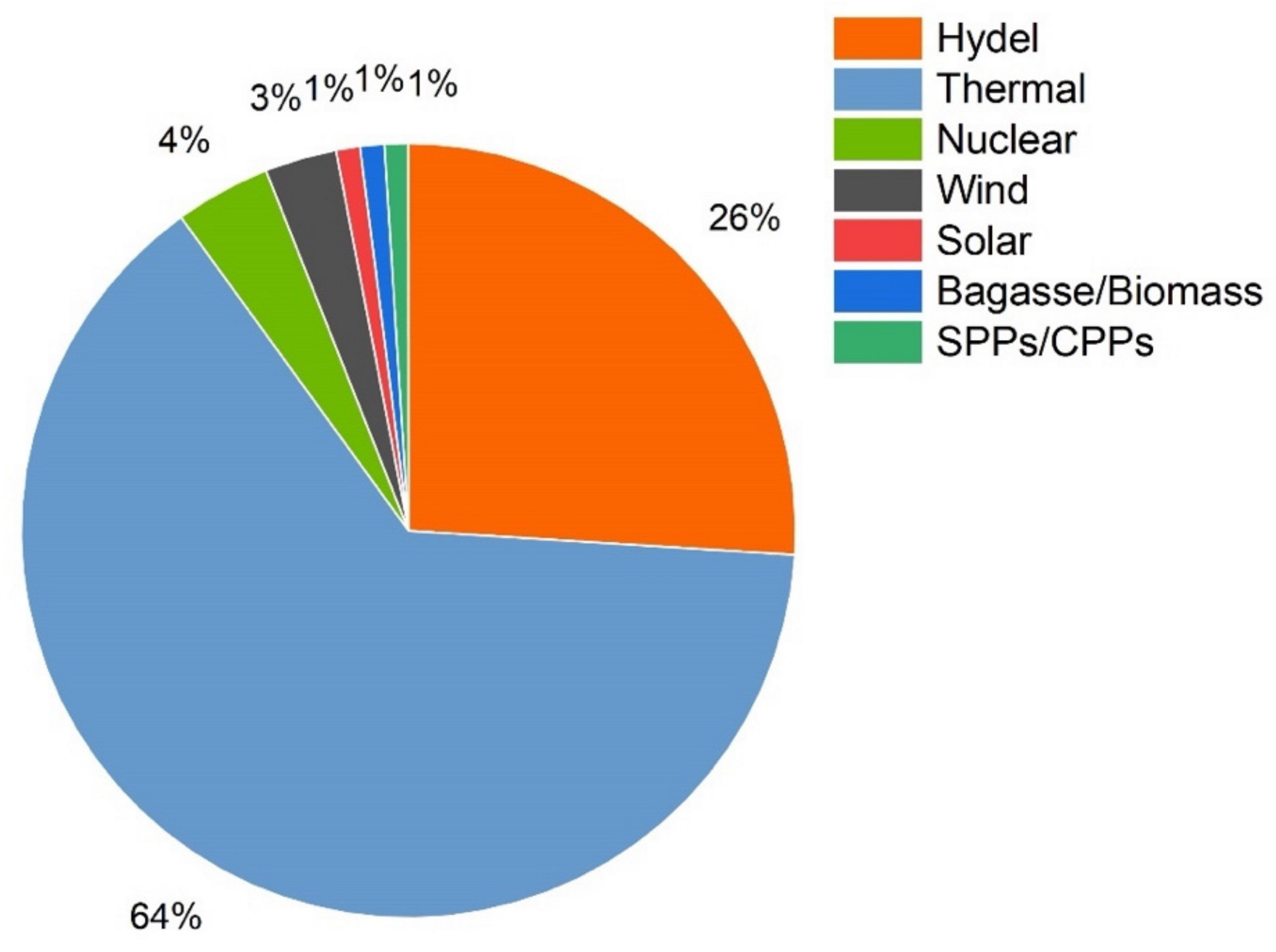
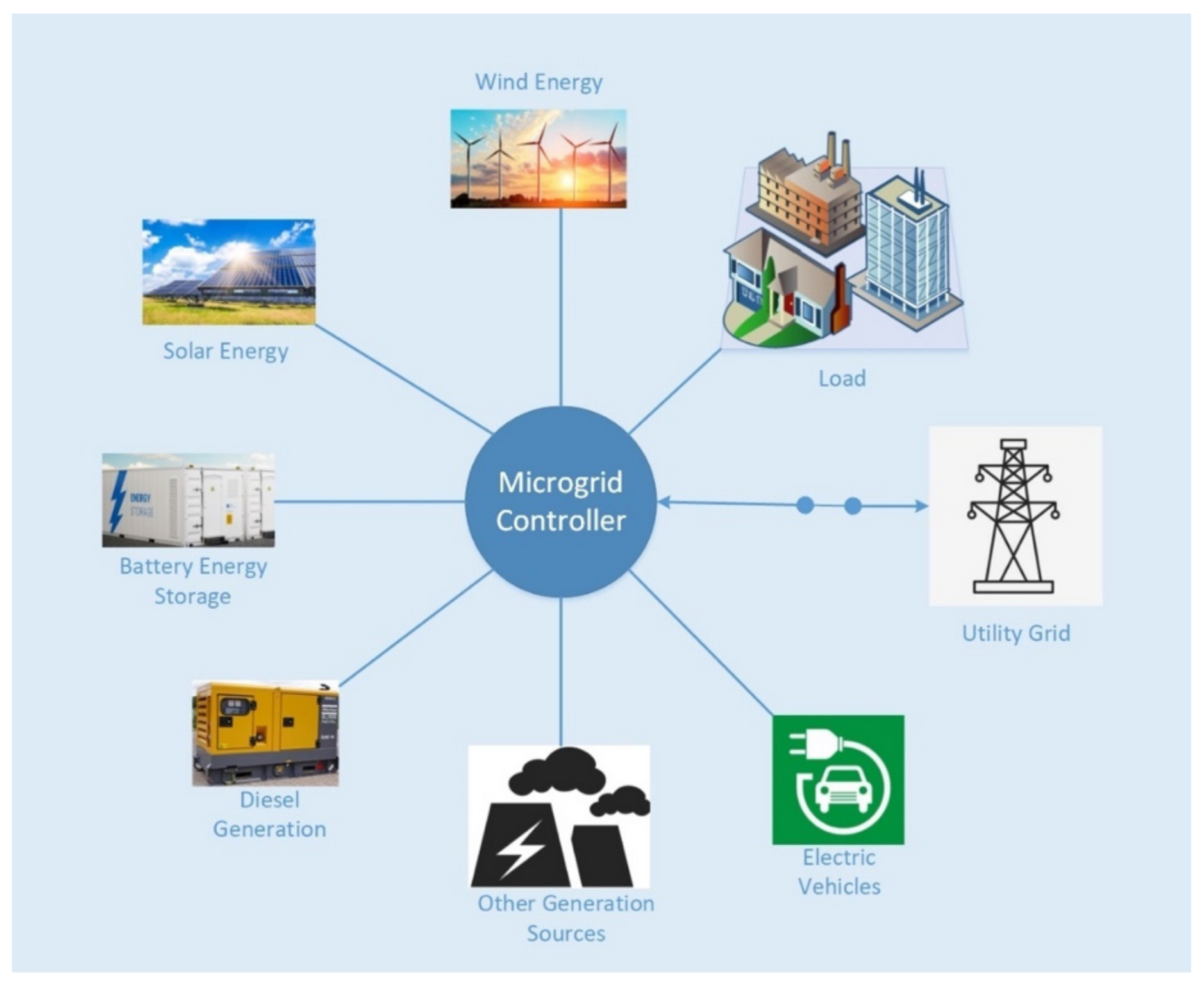
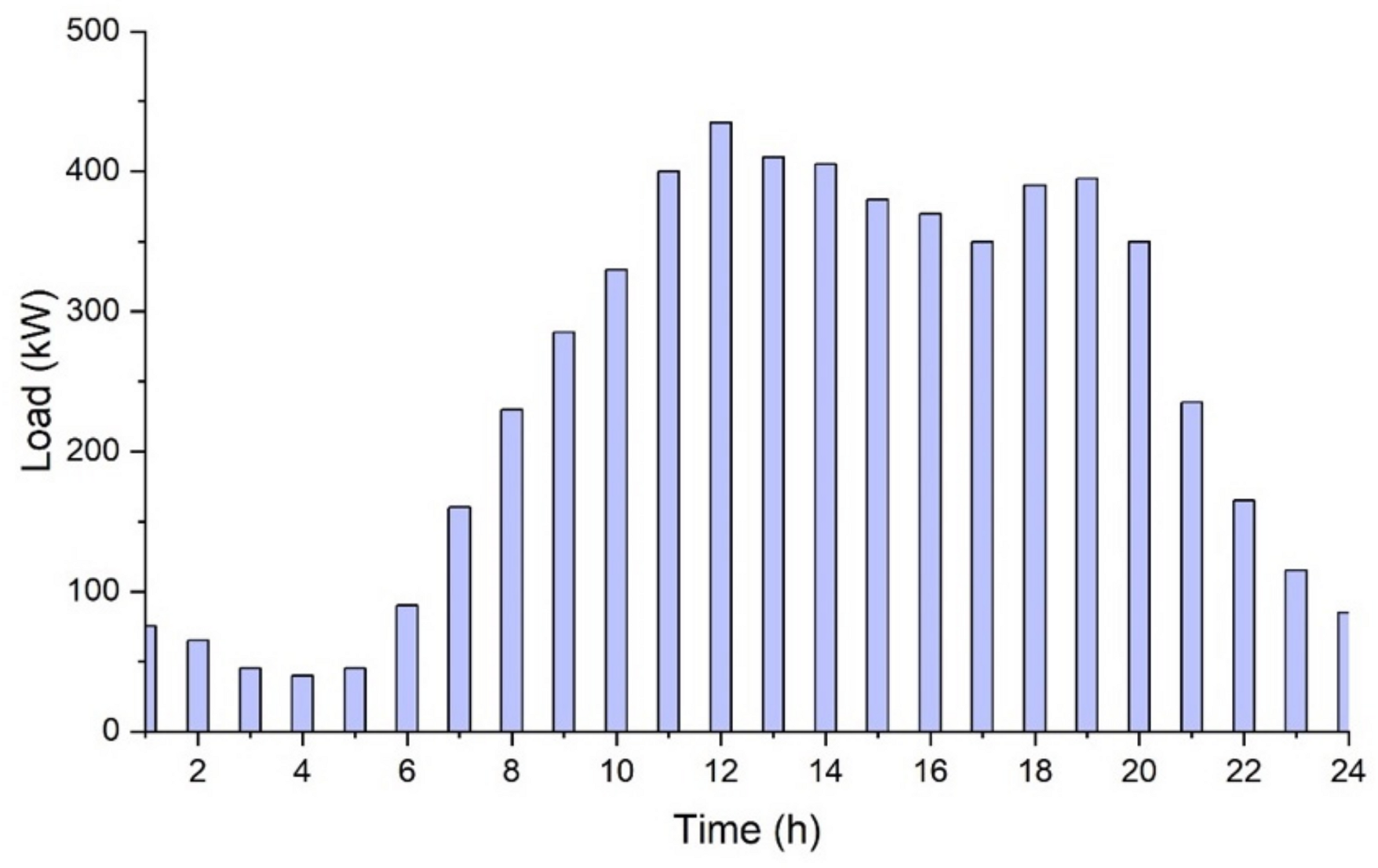
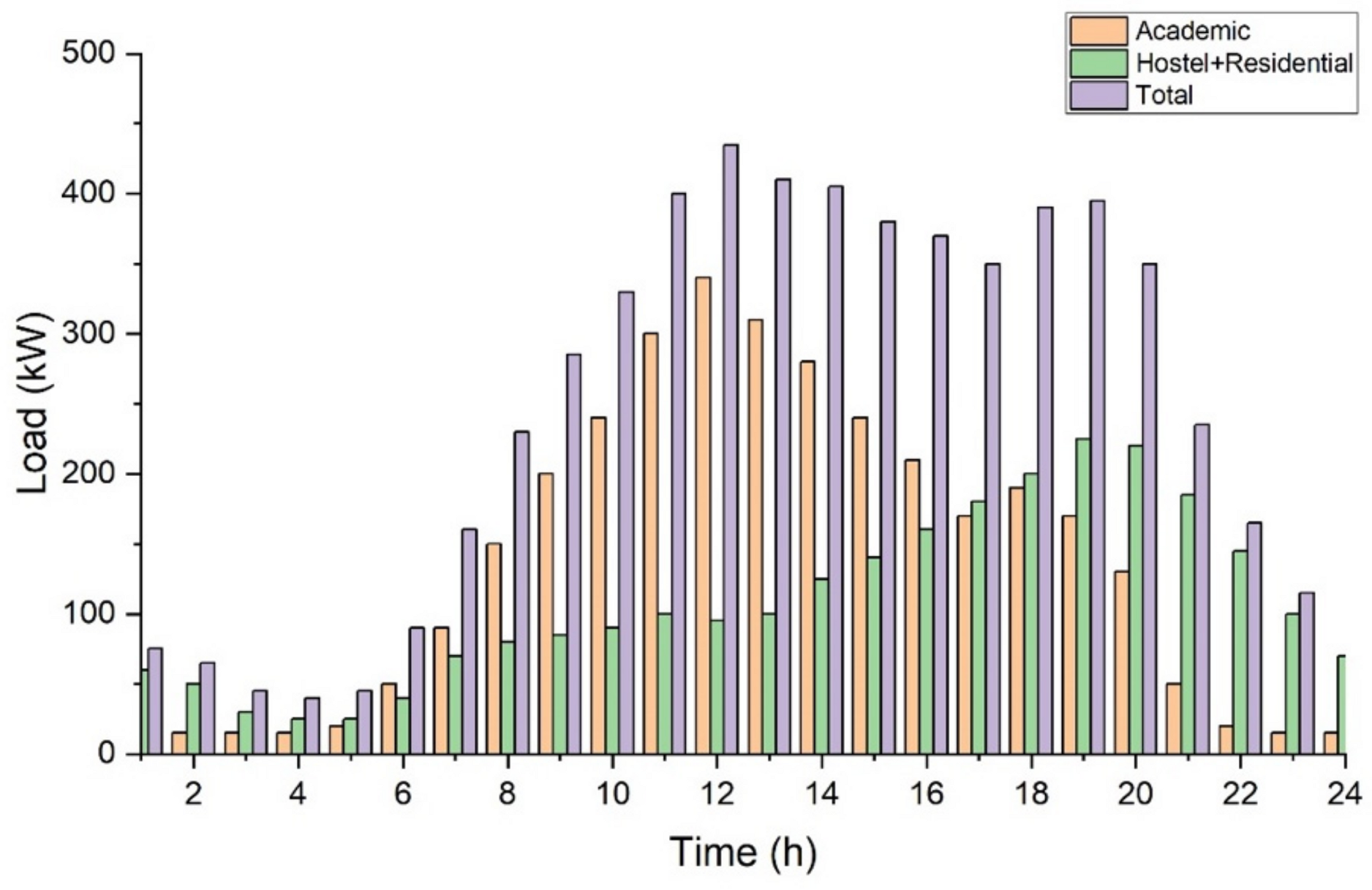

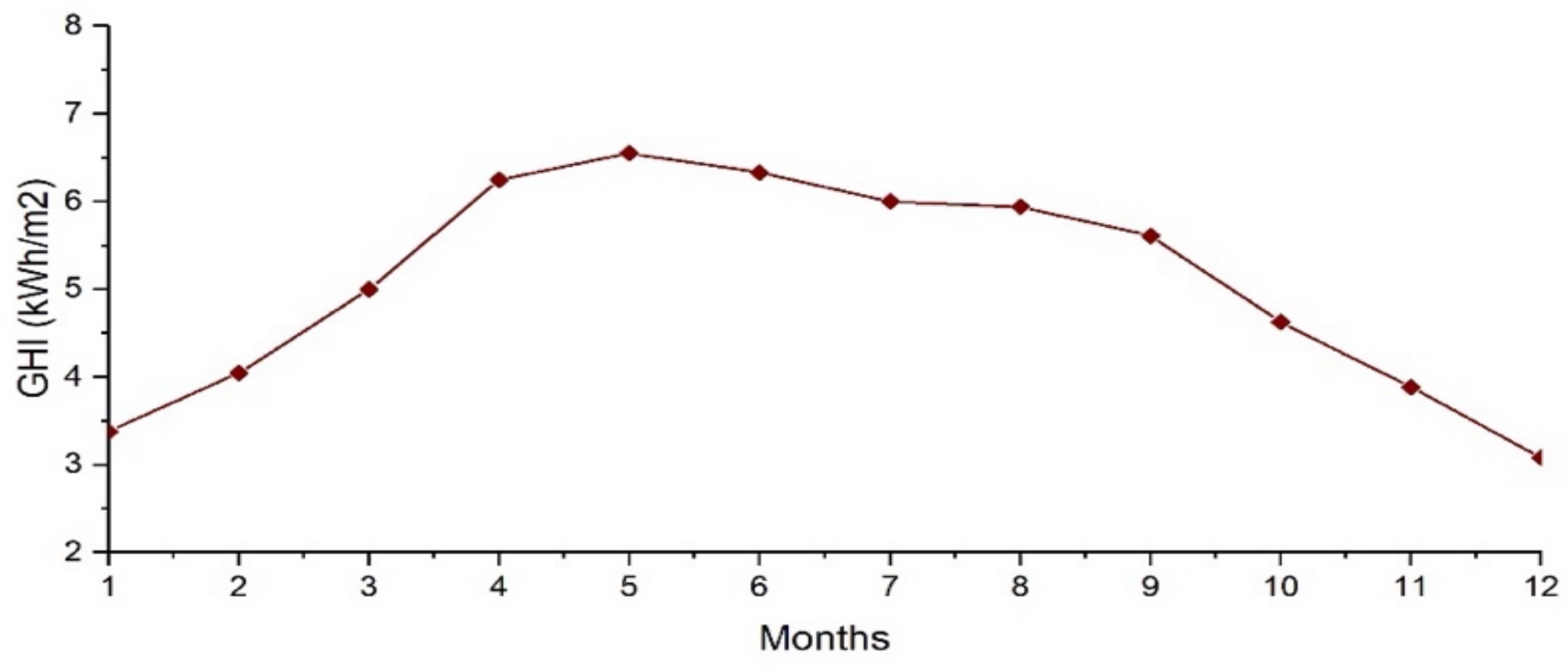
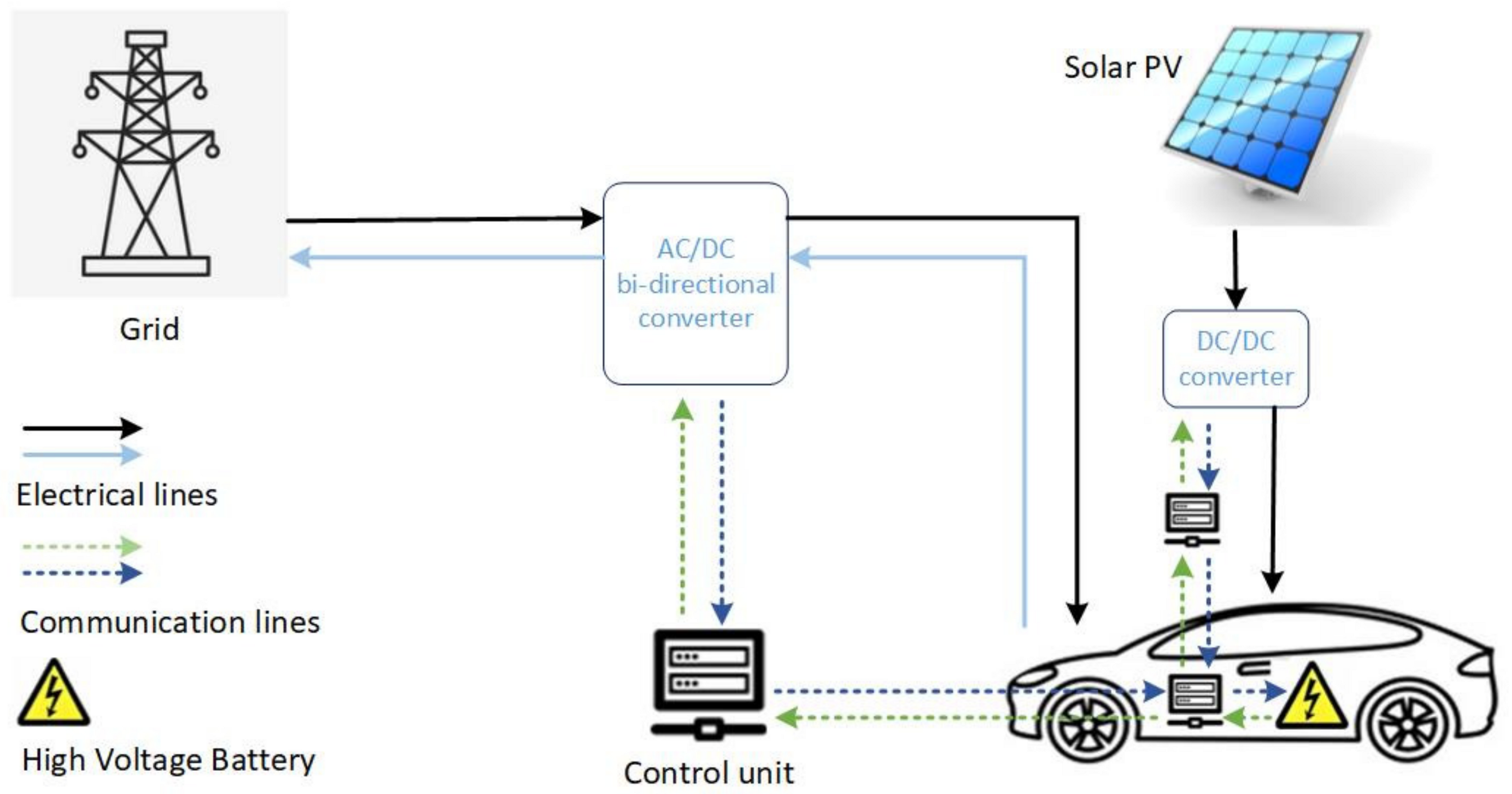
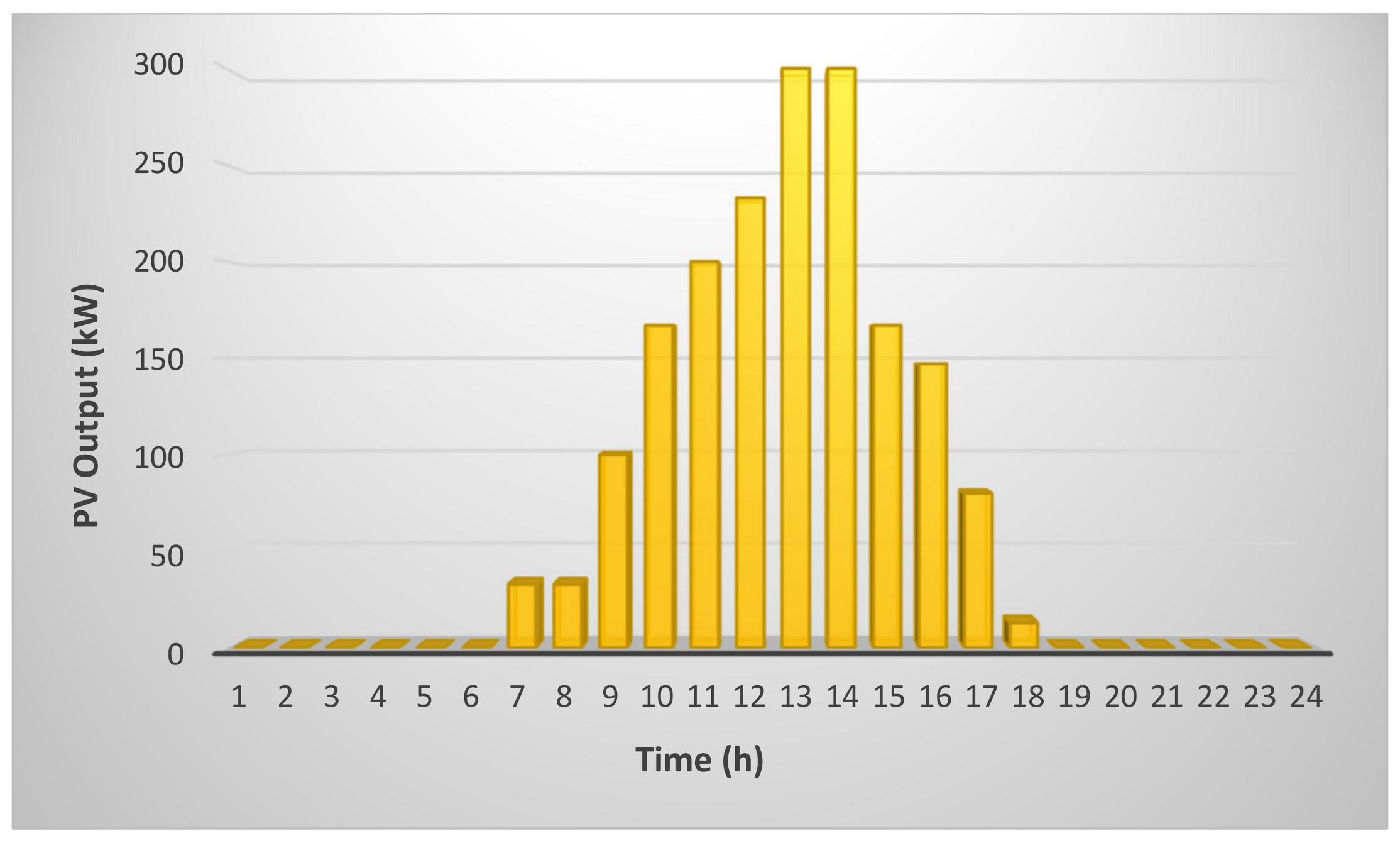
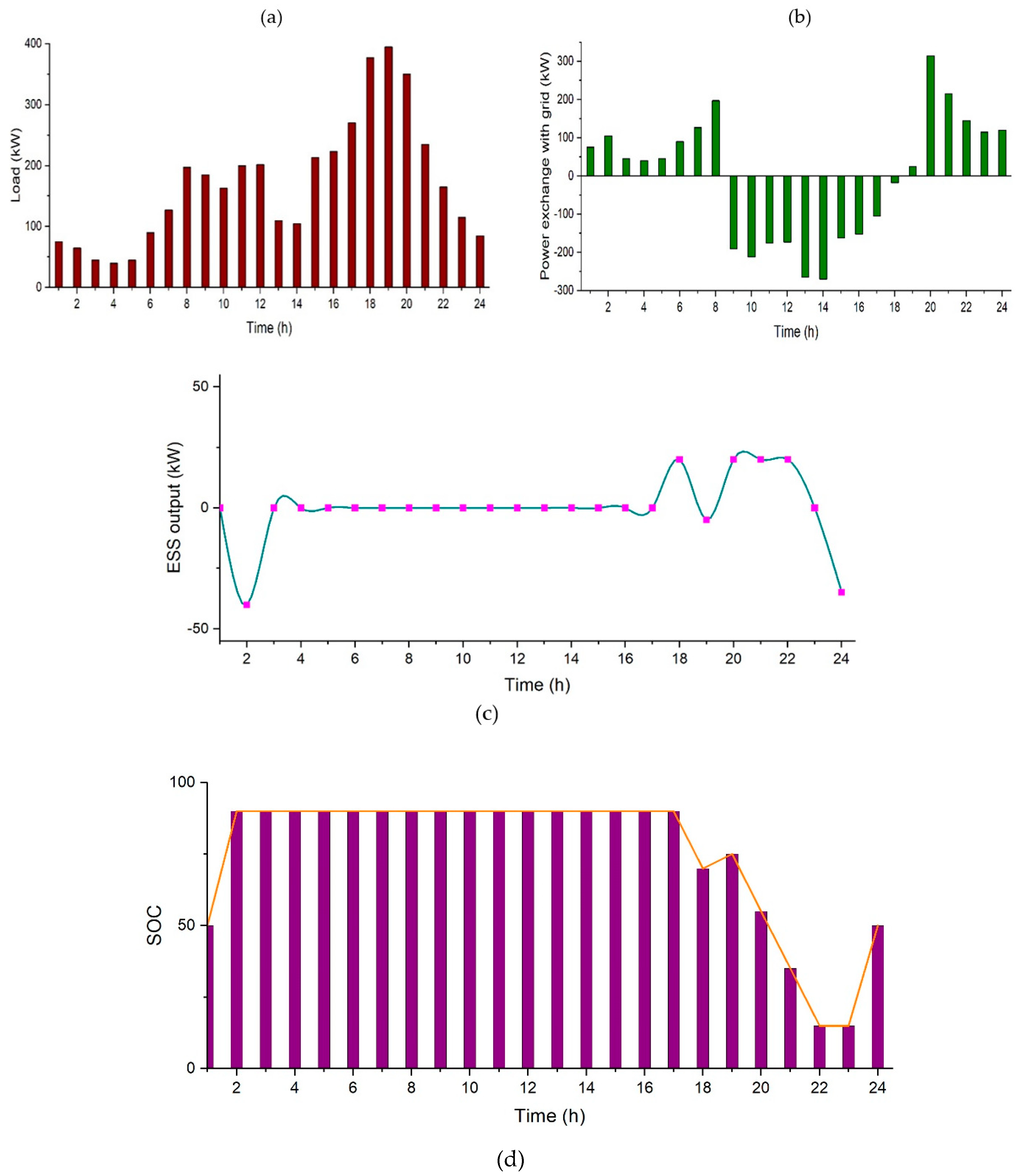
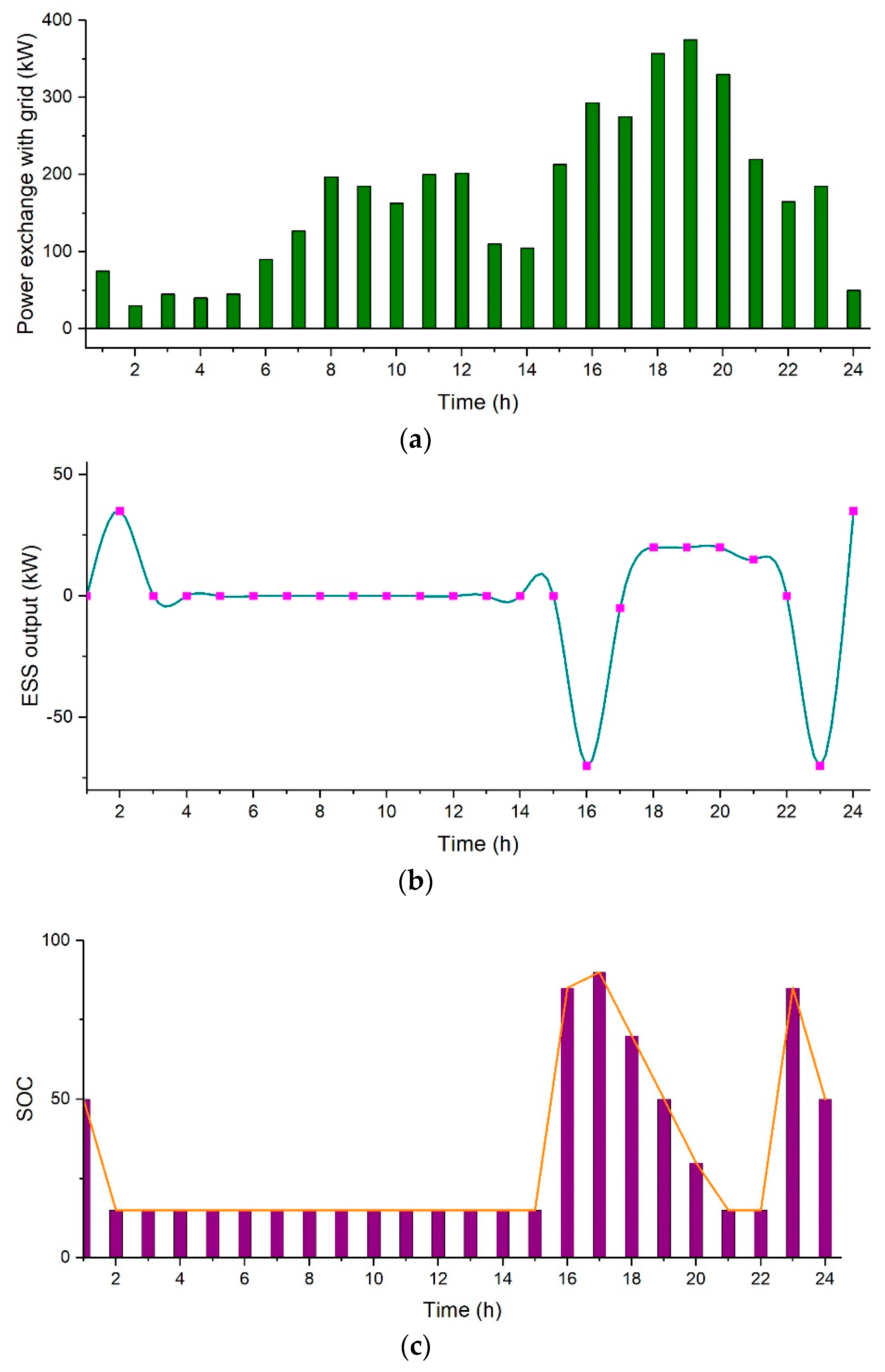
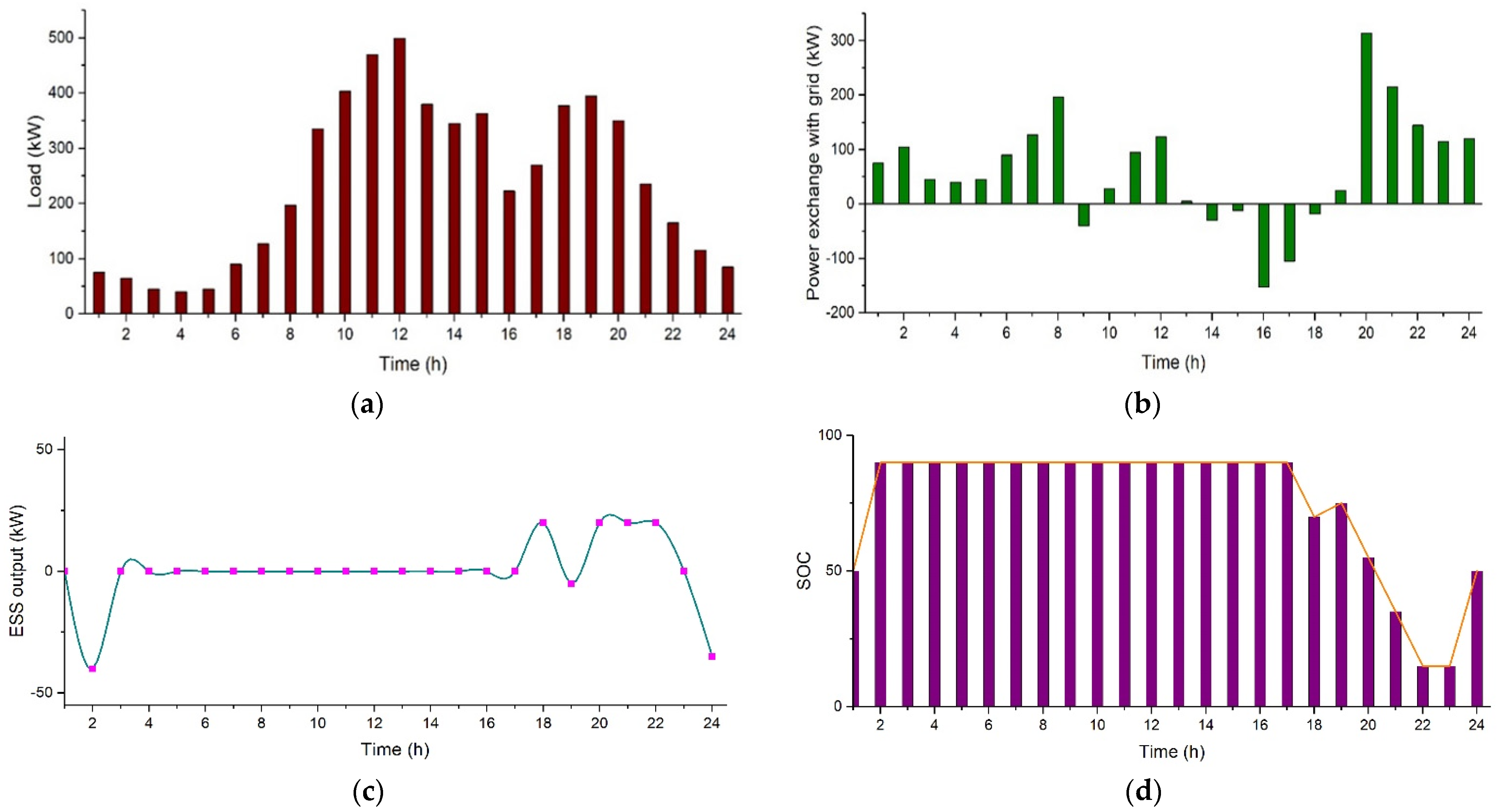
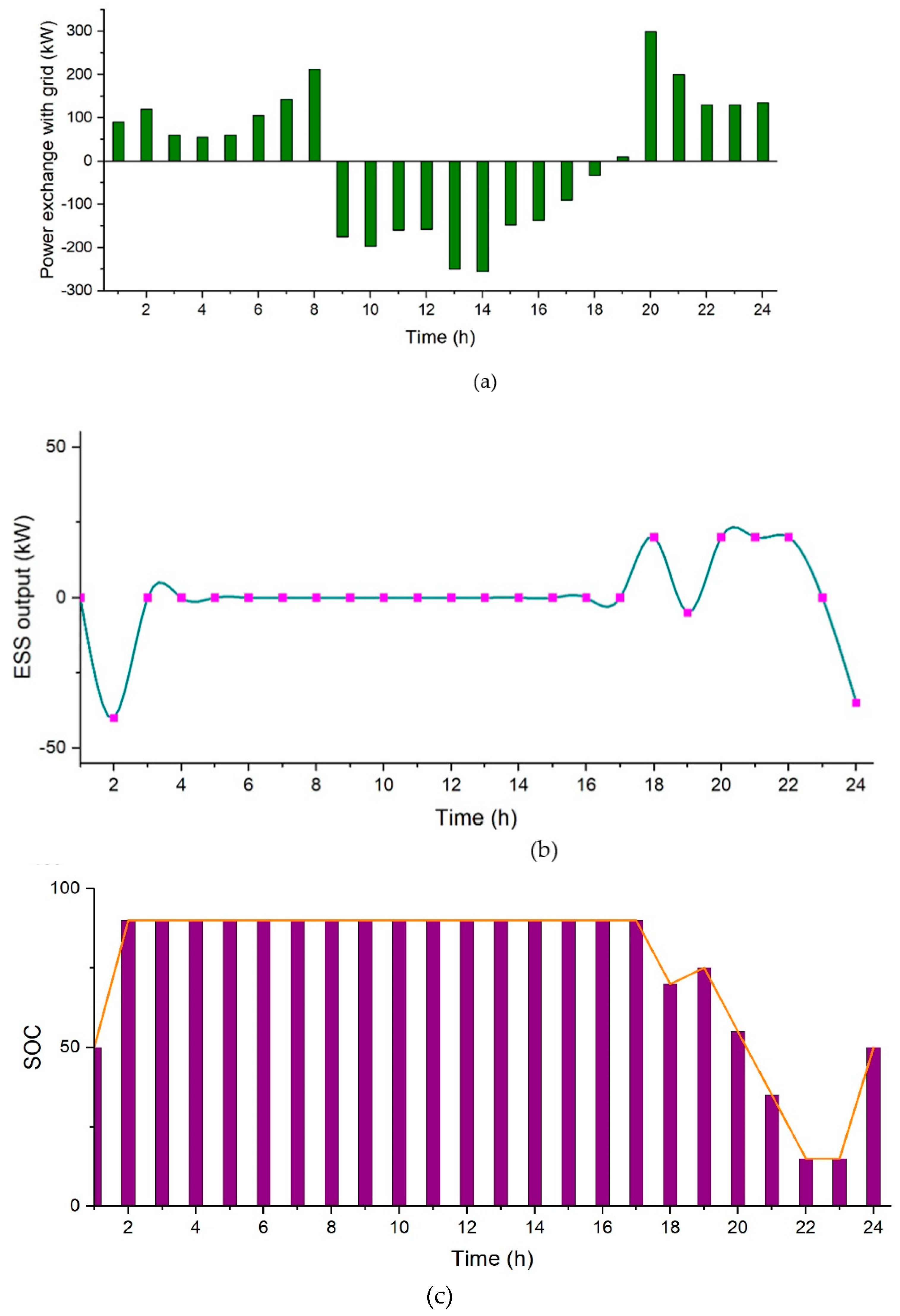
| Ref | [12] | [13] | [14] | [17] | [18] | [20] | [21] | [22] | [23] | [24] | [26] |
|---|---|---|---|---|---|---|---|---|---|---|---|
| Components | PV, BESS | PV, BESS | PV, Wind | PV, ESS, Converter | PV, wind, BESS, natural-gas turbine generator | PV, BESS | PV, BESS, Inverters, Diesel generator | PV, Wind, EV, BESS, CHP power plant | PV, BESS, Diesel generator | ||
| Algorithms | Dispatch Algorithm | Machine-learning techniques, complex event processing (CEP) | Simulated Annealing | self-crossover genetic algorithm | Mixed-integer linear programming | ||||||
| Software | HOMER | HOMER | HOMER | MATLAB | Semantic database | SCADA | MATLAB | MATLAB Toolbox | PSCAD | MATLAB | |
| Campus Name | Sebelas Maret University, Indonesia | University of Kuala Lumpur, Malaysia | Federal University of Rio de Janeiro, Brazil | Seoul National University, South Korea | University of Southern California (USC), Los Angeles | Illinois Institute of Technology (IIT), Chicago | Federal University of Para, Brazil | Anonymous | Clemson University, South Carolina | University of Novi Sad, Serbia | U.E.T, Taxila, Pakistan |
| Validity | The results were analyzed based on NPC and IRR methods | Based on total net present cost | Comparison between six different technical arrangements | Comparison without microgrid | The portal will display real-time load curtailment patterns that are detected by the CEP system for these buildings | Permanent 20% decrease in the peak load from the 2007 level | Three cases, Reference, PV, PV and BESS, are compared | Comparison with traditional optimization algorithms | The system satisfies IEEE Std 1547.4 | The microgrid is analyzed on technical, economic and ecological basis. | The microgrid is analyzed on economic and environmental basis |
| Objectives | Minimize the net present and operating costs of the system | Meet the campus load demand and minimize grid dependency | Minimize energy costs | Minimize total operating cost | Data driven DR optimization | Enhancing the microgrid reliability and economics | Minimize campus energy consumption cost | Minimize overall energy cost of the system | GHG emission reduction | Energy cost and GHG emission reduction | |
| Constraints | Budgetary constraints | Power balance, operational, ramp up/down | State of charge and Power constraints of BESS | Equality and inequality constraints | SOC constraints | ESS constraints | |||||
| Voltage/System level | Large office building | British Malaysian Institute | Technology Center | Three buildings (selected) | Three buildings on campus | 13.8-kV | Education and research | 12.5 kV | Faculty of Technical Sciences | University campus |
| Time (h) | Price ($/kWh) | |
|---|---|---|
| 1:00–18:00 | Off peak | 0.098 |
| 18:00–22:00 | Peak | 0.13 |
| 22:00–24:00 | Off peak | 0.098 |
| Components & Parameters | Case 1 (Reference Case) | Case 2 | Case 3 | Case 4 |
|---|---|---|---|---|
| Grid | √ | √ | √ | √ |
| PV | × | √ | √ | √ |
| BESS | × | √ | √ | √ |
| EV | × | × | × | √ |
| Power interruptions | × | × | √ | × |
| Cases | Cost ($/Day) | Cost Saving (%) | LCOE ($/kWh) |
|---|---|---|---|
| 1 (Reference case) | 622.42 | 0 | 0.097 |
| 2 | 343.64 | 44.80 | 0.053 |
| 3 | 461.99 | 25.78 | 0.072 |
| 4 (I) | 502.10 | 19.33 | 0.078 |
| 4 (II) | 338.72 | 45.58 | 0.052 |
Publisher’s Note: MDPI stays neutral with regard to jurisdictional claims in published maps and institutional affiliations. |
© 2021 by the authors. Licensee MDPI, Basel, Switzerland. This article is an open access article distributed under the terms and conditions of the Creative Commons Attribution (CC BY) license (https://creativecommons.org/licenses/by/4.0/).
Share and Cite
Nasir, T.; Raza, S.; Abrar, M.; Muqeet, H.A.; Jamil, H.; Qayyum, F.; Cheikhrouhou, O.; Alassery, F.; Hamam, H. Optimal Scheduling of Campus Microgrid Considering the Electric Vehicle Integration in Smart Grid. Sensors 2021, 21, 7133. https://doi.org/10.3390/s21217133
Nasir T, Raza S, Abrar M, Muqeet HA, Jamil H, Qayyum F, Cheikhrouhou O, Alassery F, Hamam H. Optimal Scheduling of Campus Microgrid Considering the Electric Vehicle Integration in Smart Grid. Sensors. 2021; 21(21):7133. https://doi.org/10.3390/s21217133
Chicago/Turabian StyleNasir, Tehreem, Safdar Raza, Muhammad Abrar, Hafiz Abdul Muqeet, Harun Jamil, Faiza Qayyum, Omar Cheikhrouhou, Fawaz Alassery, and Habib Hamam. 2021. "Optimal Scheduling of Campus Microgrid Considering the Electric Vehicle Integration in Smart Grid" Sensors 21, no. 21: 7133. https://doi.org/10.3390/s21217133







